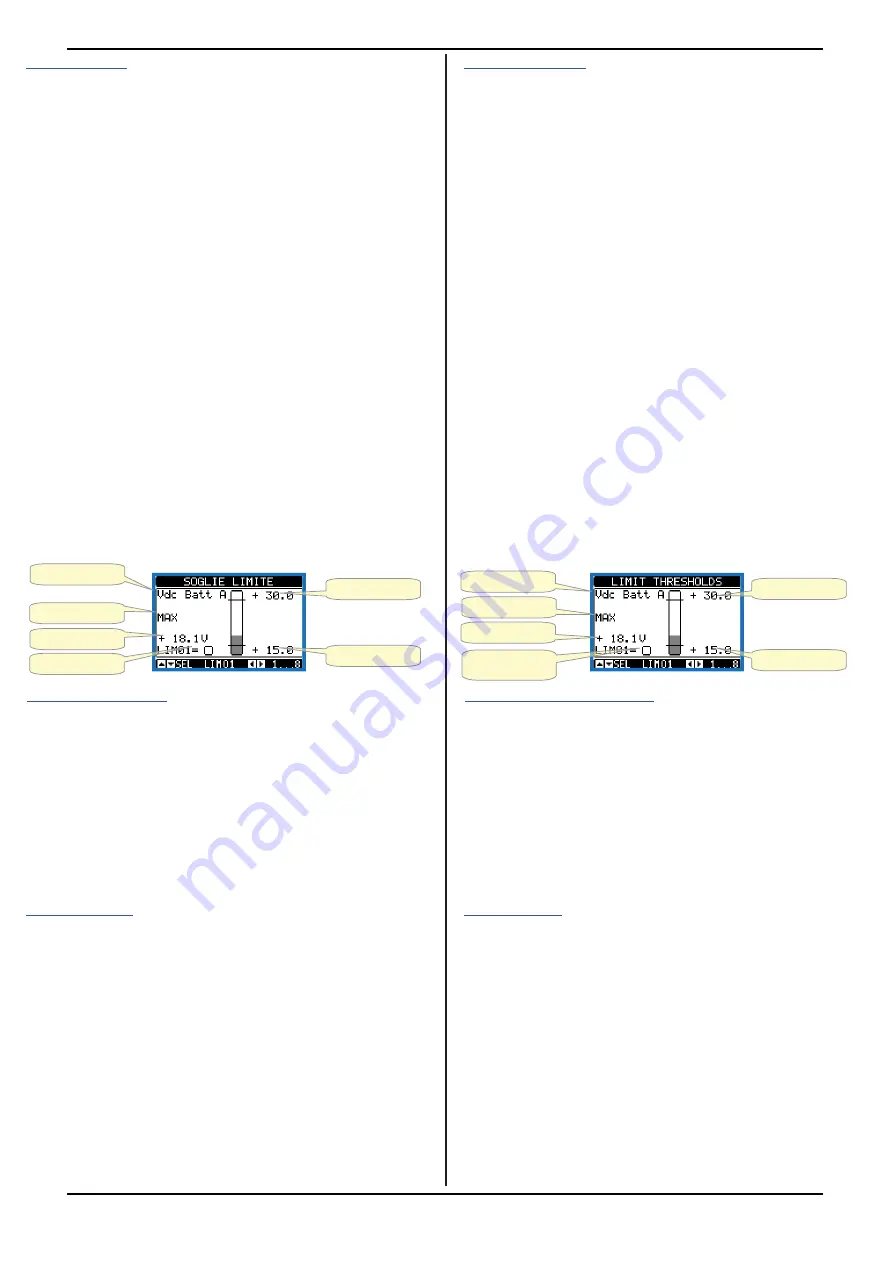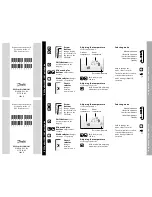
p. 1
2
Soglie limite (LIMx)
x
Le soglie limite LIMx sono delle variabili interne il cui stato dipende dalla
fuoriuscita dai limiti definiti dall’utente da parte di una misura fra quelle
effettuate dal sistema (esempio: giri del motore superiori a 2000).
x
Per velocizzare l’impostazione delle soglie, che possono spaziare in un range
estremamente ampio, ciascuna di esse va impostata con un valore base + un
coefficiente moltiplicativo (esempio: 2 x 1k = 2000).
x
Per ogni LIM sono disponibili due soglie (superiore ed inferiore). La soglia
superiore deve essere sempre impostata ad un valore maggiore di quella
inferiore.
x
il significato delle soglie dipende dalle seguenti funzioni:
Funzione Min
: con la funzione Min la soglia inferiore è d’intervento quella
superiore di ripristino. Quando il valore della misura selezionata è sotto il limite
inferiore, dopo il ritardo impostato si ha l’attivazione della soglia. Quando il valore
della misura è maggiore della soglia superiore, dopo il ritardo impostato si ha il
ripristino.
Funzione Max:
con la funzione Max la soglia superiore è d’intervento quella
inferiore di ripristino. Quando il valore della misura selezionata è maggiore della
superiore, dopo il ritardo impostato si ha l’attivazione della soglia. Quando il
valore della misura è minore della soglia inferiore, dopo il ritardo impostato si ha il
ripristino.
Funzione Min+Max:
con la funzione Min+Max le soglie inferiore e superiore
sono entrambe d’intervento. Quando il valore della misura selezionata è minore
della soglia inferiore o maggiore della soglia superiore, dopo i rispettivi ritardi si ha
l’intervento della soglia. Quando il valore della misura rientra nei limiti si ha il
ripristino immediato.
x
L’intervento può significare eccitazione o diseccitazione del limite LIMx a
seconda dell’impostazione.
x
Se il limite LIMx è impostato con memoria, il ripristino è manuale e può essere
effettuato tramite il comando apposito nel menu comandi.
x
Vedere il menu d’impostazione M18.
Limit thresholds (LIMx)
x
The LIMx thresholds are internal variables whose status depends on the out-of-
limits of one particular measurement set by the user (e.g. engine RPM higher
than 2000) among all those measured.
x
To make the setting of the thresholds easier, since the limits can span in a very
wide range, each of them can be set using a base number and a multiplier (for
example: 2 x 1k = 2000).
x
For each LIM, there are two thresholds (upper and lower). The upper threshold
must always be set to a value higher than the lower threshold.
x
The meaning of the thresholds depends on the following functions:
Min function:
the lower threshold defines the trip point, while the upper threshold
is for the resetting. The LIM trips when the selected measurement is less than the
Lower threshold for the programmed delay. When the measured value becomes
higher than the upper setpoint, after the set delay, the LIM status is reset.
Max function:
the
upper threshold defines the trip point, while the lower threshold
is for the resetting. The LIM trips when the selected measurement is more than
upper threshold for the programmed delay. When the measured value decreases
below the lower setpoint, after the delay, the LIMx status is reset.
Max+Min function:
both thresholds are for tripping. When the measured value is
less than lower or more than upper set points, then, after the respective delays,
the LIM will trip. When the measured value returns within the limits, the LIM status
will be immediately reset.
x
Trip indicates either activation or de-activation of the LIM variable, depending
on ‘Normal status’ setting.
x
If the LIMx latch is enabled, the reset can be done only manually using the
dedicated command in the commands menu.
x
See setup menu M18.
Variabili da remoto (REMx)
x
FF128DP ha la possibilità di gestire un massimo di 16 variabili comandate da
remoto (REM1…REM16).
x
Si tratta di variabili il cui stato può essere modificato a piacere dall’utente
tramite il protocollo di comunicazione e che possono essere utilizzate in
abbinamento alle uscite, alla logica Booleana etc.
x
Esempio: usando una variabile remota (REMx) come sorgente di un’uscita
(OUTx) sarà possibile attivare e disattivare liberamente un relè tramite il
software di supervisione. Questo consentirebbe di utilizzare i relè di uscita del
FF per comandare dei carichi ad esempio illuminazione o altro.
x
Un altro utilizzo delle variabili REM può essere quello di abilitare o disabilitare
determinate funzioni da remoto, inserendole in una logica Booleana in AND
con ingressi o uscite.
Remote-controlled variables (REMx)
x
FF128DP can manage up to 16 remote-controlled variables (REM1…REM16).
x
Those are variables which status can be modified by the user through the
communication protocol and that can be used in combination with outputs,
Boolean logic, etc.
x
Example: using a remote variable (REMx) as a source for an output (OUTx), it
will be possible to freely energise or de-energise one relay through the
supervision software. This allows to use the FF relays to drive lighting or
similar loads.
x
Another possible use of REM variables is to enable/disable other functions
remotely, inserting them into a Boolean logic in AND with inputs or outputs.
Allarmi utente (UAx)
x
L’utente ha la possibilità di definire un massimo di 8 allarmi programmabili
(UA1…UA8).
x
Per ciascun allarme è possibile stabilire:
1. la
sorgente
, cioè la condizione che genera l’allarme;
2. il
testo
del messaggio che deve comparire sul display quando questa
condizione si verifica;
3. le
proprietà
dell’allarme (come per gli allarmi standard), cioè in che modo
esso interagisce con il controllo del gruppo elettrogeno.
x
La condizione che genera l’allarme può essere ad esempio il superamento di
una soglia. In questo caso la sorgente sarà una delle soglie limite LIMx.
x
Se invece l’allarme deve essere visualizzato in conseguenza dell’attivazione di
un ingresso digitale esterno, allora la sorgente sarà un INPx.
x
Con lo stesso criterio è possibile abbinare ad un allarme anche condizioni
complesse risultanti dalla combinazione logica Booleana di ingressi, soglie, etc.
In questo caso si utilizzeranno le variabili PLCx.
x
Per ciascun allarme l’utente ha la possibilità di definire un messaggio
liberamente programmabile che comparirà sulla finestra pop-up degli allarmi.
User Alarms (UAx)
x
The user has the possibility to define a maximum of 8 programmable alarms
(UA1…UA8).
x
For each alarm, it is possible to define:
1. the
source
that is the condition that generates the alarm;
2. the
text
of the message that must appear on the screen when this
condition is met;
3. the
properties
of the alarm (just like for standard alarms), that is in which
way that alarms interacts with the generator control.
x
The condition that generates the alarm can be, for instance, the overcoming of
a threshold. In this case, the source will be one of the limit thresholds LIMx.
x
If instead, the alarm must be displayed depending on the status of an external
digital input, then the source will be an INPx.
x
With the same criteria, it is possible to also link complex conditions to an alarm,
resulting from the logic combination of inputs, limits, etc. In this case, the
Boolean logic variables PLCx must be used.
x
For every alarm, the user can define a free message that will appear on the
alarm page.
Tipo di misura
Funzione
Valore della misura
Soglia superiore
Soglia inferiore
Stato variabile limite
Type of measure
Function
Measure value
Upper threshold
Lower threshold
Status of the limit
variable
Содержание LOWARA FF128DP Series
Страница 2: ......













































